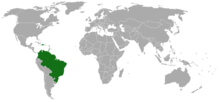Anadenanthera peregrina
| Anadenanthera peregrina | |
|---|---|
 |
|
| Scientific classification | |
| Kingdom: | Plantae |
| (unranked): | Angiosperms |
| (unranked): | Eudicots |
| (unranked): | Rosids |
| Order: | Fabales |
| Family: | Fabaceae |
| Genus: | Anadenanthera |
| Species: | A. peregrina |
| Binomial name | |
|
Anadenanthera peregrina (L.) Speg. |
|
 |
|
| Range of Anadenanthera peregrina | |
| Synonyms | |
|
Acacia angustiloba DC. |
|
Acacia angustiloba DC.
Acacia microphylla Willd.
Acacia peregrina (L.) Willd.
Inga niopo Willd.
Mimosa acacioides Benth.
Mimosa niopo (Willd.) Poiret
Mimosa parvifolia Poiret
Mimosa peregrina L.
Niopa peregrina (L.) Britton & Rose
Piptadenia niopo (Willd.) Spruce
Piptadenia peregrina (L.) Benth.
Anadenanthera peregrina, also known as yopo, jopo, cohoba, parica or calcium tree, is a perennial tree of the Anadenanthera genus native to the Caribbean and South America. It grows up to 20 m (66 ft) tall, having a horny bark. Its flowers are pale yellow to white and spherical. It is not listed as being a threatened species. It is an entheogen used in healing ceremonies and rituals. It is also a well known source of dietary calcium.
This plant is almost identical to that of a related tree, Anadenanthera colubrina, commonly known as cebíl or vilca. The beans of A. colubrina have a similar chemical makeup as Anadenanthera peregrina, with their primary constituent being bufotenin.
The wood from A. peregrina is very hard and it is good for making furniture. It has a Janka rating of 3700 lb. and a density of around 0.86 g/cm³.
...
Wikipedia
